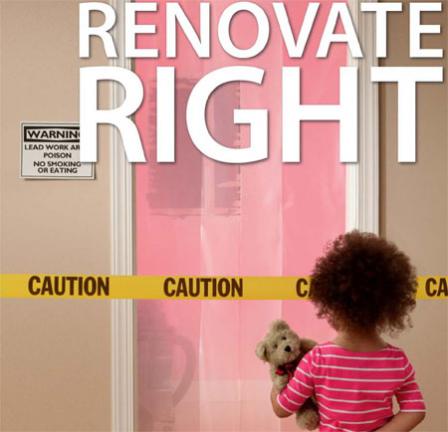Renovation, Repair and Painting Program: Contractors
If you are a renovation firm, then we recommend you read through all of the subjects below to learn how to fulfill your legal requirements to protect yourself, your employees, and your clients from the dangers of lead exposure.
Overview | Firm Certification | Renovator Training | Work Practices | Resources
As a contractor, you play an critical role in helping to prevent lead exposure. Ordinary renovation and maintenance activities can create toxic lead dust that can harm your customers, workers and even yourself. But by following lead-safe work practices, you can prevent lead hazards.

On this page you'll find:
Renovation Program Overview
The Lead Renovation, Repair and Painting (RRP) Rule Exitestablishes requirements for firms and individuals performing renovations, and affects contractors, property managers and others who disturb painted surfaces. It applies to work in houses, apartments and child-occupied facilities (such as schools and child care centers) built before 1978. It includes pre-renovation education requirements as well as training, firm certification and work practice requirements.
Firms that Require Certification
In general, anyone who is paid to perform work that disturbs paint in housing and child-occupied facilities built before 1978 must be certified. This includes all firms, even sole proprietorships.
Examples of the types of firms covered:
- Residential rental property owners/managers;
- General contractors; and
- Special trade contractors, including painters, plumbers, carpenters and electricians.
Firms cannot advertise or perform renovation activities covered by the RRP Rule in homes or child-occupied facilities built before 1978 without firm certification.
Activities Covered By the Rule
- In general, any activity that disturbs paint in pre-1978 housing and child-occupied facilities is covered, including:
- Remodeling and repair/maintenance;
- Electrical work;
- Plumbing;
- Painting preparation;
- Carpentry; and
- Window replacement.
- The following housing or activities are not covered by the rule:
- Housing built in 1978 or later;
- Housing specifically for elderly or disabled persons, unless children under 6 reside or are expected to reside there;
- "Zero-bedroom" dwellings (studio apartments, dormitories, etc.);
- Housing or components declared lead-free by a certified inspector or risk assessor. Also, a certified renovator may declare specific components lead-free using an EPA recognized test kit or by collecting paint chip samples for analysis by an EPA recognized laboratory; and
- Minor repair and maintenance activities that disturb 6 square feet or less of paint per room inside, or 20 square feet or less on the exterior of a home or building. (Note: Window replacement, and partial and full demolition activities, are always covered regardless of square footage. Activities designated as “prohibited” are prohibited regardless of square footage.).
Paint testing
Paint testing is not required by the RRP Rule, but unless you have documentation that the paint is not lead-based, then the requirements of the RRP Rule apply.
If you or your client chooses to have the paint tested prior to renovation, testing must be done by the appropriate qualified professional on all surfaces to be affected by the work.
| Type of Paint Testing for Renovations | Who Can Do the Testing? |
|---|---|
| EPA-recognized test kits | Certified renovators |
| X-Ray Fluorescence instruments | Certified lead-based paint inspectors or risk assessors |
| Paint chip sampling | Certified renovator, inspector or risk assessor |
